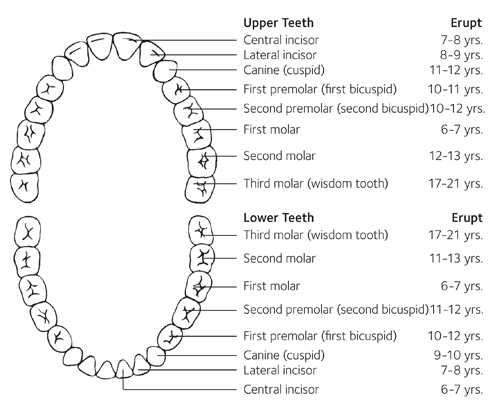10 Questions with an orthodontist
Your child’s teeth – you want them to have that beautiful smile, but just the mere mention of the word orthodontist can send some people into a panic. That’s why Urban Suburban Mommy caught up with orthodontist Dr. Ana Urdaneta. We asked her the 10 questions we know you want to know. Her answers will give you courage, confidence and hope that your child’s smile is all under control:
1. At what age can you tell if a child will need orthodontic work?
 It varies, depending on the case. Usually, once the first adult molars and anterior incisors (Central and Lateral Incisors on the diagram) come in, the child is considered in mixed dentition (baby and adult teeth at the same time). At that time we can evaluate and start projecting what type of malocclusion (imperfect positioning of the teeth when the jaws are closed), if any, the child will have.
It varies, depending on the case. Usually, once the first adult molars and anterior incisors (Central and Lateral Incisors on the diagram) come in, the child is considered in mixed dentition (baby and adult teeth at the same time). At that time we can evaluate and start projecting what type of malocclusion (imperfect positioning of the teeth when the jaws are closed), if any, the child will have.
2. When do you begin orthodontic work on a child?
Most times it’s better to wait until almost all of the adult teeth have erupted, but depending on the type of malocclusion, a child might need early intervention (as early as 6 years old). In these early cases we just try to modify the child’s growth pattern to guide teeth into proper development.
3. How can a family find a good orthodontist?
You should be able to trust your family dentist’s orthodontic recommendation. It’s always good to meet with someone that has been recommended and get a feel on their knowledge and treatment to decide if you’re comfortable.
4. Are bad teeth hereditary? For example if I wore braces, is it likely my children will?
Sometimes a malocclusion can be due to a genetic component, but there are other causes for bad teeth. Habits like thumb sucking and tongue thrust can lead to open and cross bites. Sometimes it’s just the way we’re born that we unfortunately get crowded teeth. In any case, it’s always good to have early check ups and start planning in advanced if treatment is going to be needed.
5. Are there any factors during childhood that lead to the need for orthodontic work?
As mentioned, habits like thumb sucking can cause malocclusions. If the affecting habits continue through the years that adult teeth start coming in (5-6 years), this could cause not only a dental malocclusion, but a skeletal growth modification as well.
6. Why is orthodontic work expensive?
It’s not only that the materials used for a single orthodontic patient are very expensive, the hours of studying and practicing to become an orthodontist are a extensive. It’s a complex equation. Also consider that an orthodontic treatment spans over 18 to 28 months on average, and the fee is usually spread over that time frame on multiple visits.
7. What are the latest break throughs that you can share relating to orthodontics?
Everyday there are new appliances that make treatments more reliable and effective. I really like the things that Invisalign, are doing. It’s a great alternative for people who do not want to wear brackets, and it works just as well.
8. How do you reassure your patients that their braces or other devices will help in the long run?
I usually show them examples of other similar cases. Seeing is believing!
9. What is the hardest thing about being an orthodontist?
Beside all the years and money that it takes a dentist to become an orthodontist, I would have to say that the posture while working is one of the hardest things. Most orthodontists and dentists end up with some sort of back problem after a few years of practicing. We try our best following all the ergonomic alternatives that are out there, but it’s still hard.
10. What is the most rewarding thing about being an orthodontist?
To see that beautiful smile on your patient at the end of treatment, not only because they have perfectly aligned teeth, but most of all because they are so happy with the results!
 Dr. Ana Urdaneta was born and raised in Caracas, Venezuela where she completed a Bachelor of Science and graduated from Dental School with Honours, Magna Cum Laude. She obtained a Masters of Science degree in Orthodontics at Intercontinental University in Mexico City in 2006, and was earned her specialty Certification in Orthodontics at the University of Toronto where she is a clinical instructor in the Department of Orthodontics. Working both at the University of Toronto and in private practice, she has learned the importance of understanding the patient’s needs and desires in order to achieve successful treatment.
Dr. Ana Urdaneta was born and raised in Caracas, Venezuela where she completed a Bachelor of Science and graduated from Dental School with Honours, Magna Cum Laude. She obtained a Masters of Science degree in Orthodontics at Intercontinental University in Mexico City in 2006, and was earned her specialty Certification in Orthodontics at the University of Toronto where she is a clinical instructor in the Department of Orthodontics. Working both at the University of Toronto and in private practice, she has learned the importance of understanding the patient’s needs and desires in order to achieve successful treatment.











Thank you for sharing the information. This article would help the people to know about the problem with the high pitch roofs and probably found the possible solution to it.
thank you for sharing this article. Looking forward to more!
Lovely post!! thanks for sharing this post here with us.